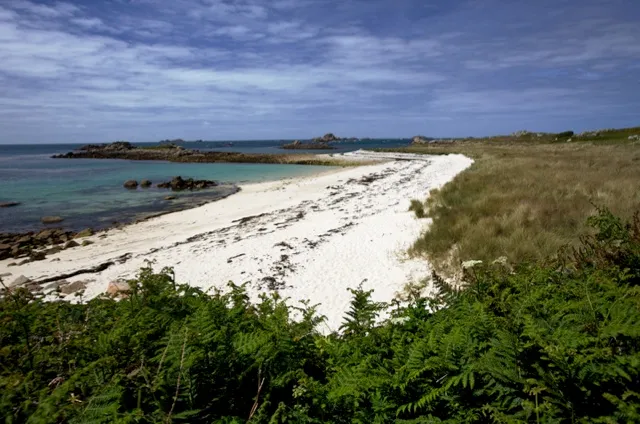
There are five inhabited islands in the isles of Scilly and Bryher is the smallest of them all, so you might think it would be the least interesting. Not a bit of it. You’ll find more variations of scenery in this little patch of land than in some English counties.
1 Bar crawl
The obvious starting point for an exploration is the Bar, the quay where boats usually land. Walking across the sands, you turn right by the boatyard to reach The Town. This is a very grand name for a little cluster of cottages, the island’s only shop and post office and the Fraggle Rock Bar, which is a great place to eat, especially if you like seafood. It’s pretty good for beer drinkers as well – and you don’t have to take my word for it. Jamie Oliver lists it among Britain’s best boozers.
Mind you, if you eat at one of the outside tables, you may feel obliged to share some of your food: the world’s cheekiest sparrows hop right up on the table to scavenge whatever they can steal. After refreshment, go exploring: the best way to see the island is simply to walk around the edge.
2 Beach beauty
From the café, the obvious road (more of a track really), leads out past the little sandy bay. This is a very sheltered spot, separated from neighbouring Tresco by a narrow channel that is a favourite anchorage for visiting yachts. It could be a Mediterranean view: the sea is blue, the sands are white and the water is warm and clear.
At low tide you might see a wandering oystercatcher or more exotic visitors such as egrets, which have become quite common here in recent years. There is a slightly macabre note as well – the rock in the bay is Hangman Island, though there is some doubt about the name: some say Admiral Blake used it for executions in the Civil War.
A rather more likely version is that it simply comes from ‘an men’, Cornish for The Rock.
3 Dartmoor-on-sea
Now the scenery changes, as a path leads up over bracken covered moorland to a rocky promontory, a jumbled mass of granite, giving the impression you might have reached a sort of seaside Dartmoor. This is a pleasant place to sit for a while and look out beyond Tresco to the scattered islands to the east. The moorland now dips down again, for an attractive grassy walk above the cliffs, before rising up towards Shipman Head, the northernmost tip of the island.
Now the scenery is altogether more dramatic. The coastline is rugged and instead of being sheltered, it is now exposed to the Atlantic. Head west from here, and America.
We all like fine, sunny weather on holiday, but a blustery day here, with the waves crashing on the rocks, has its own magic. Turning back south down the opposite side of the island brings you to Hell Bay. It’s easy to see how it got its name. In the days of sail, any vessel caught here in a storm would have been blown in by wind and waves to inevitable destruction.
4 Waterfowl Haven
Continuing the circuit, the landscape changes yet again. A large inland pool, formed by abandoned peat diggings, offers home to waterfowl. Anyone who wants to go back to the start can take the broad track from here, while hardier walkers can continue on.
The next part of the coast is sheltered by outlying islands so we are treated once again to a lovely little sandy crescent bay. This seems to be a popular spot for seals, who either come ashore to bask in the sun or float out in the bay, seeming to take an interest in whatever’s happening on land.
5 Invader evasion
At the southern tip is Droopy Nose Point, with its stacks of boulders. This is not a natural phenomenon: the inhabitants piled them up centuries ago as a defence against Viking invaders. Heading back up the east side, pass a sheltered area where spring flowers bloom before their mainland cousins, due to the climate. It’s a short walk back to the quay.
The great beauty of this island is that you don’t haveto follow any particular route and can more or less wander where you like, but wherever.
